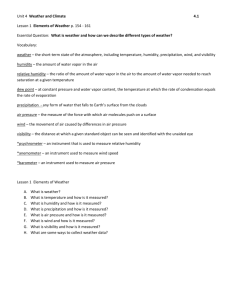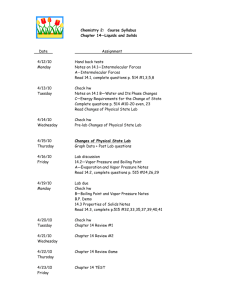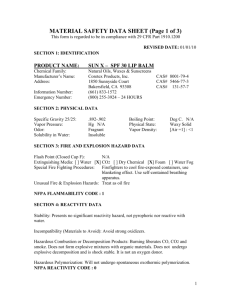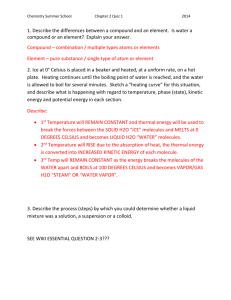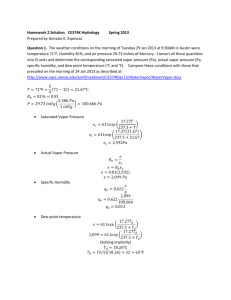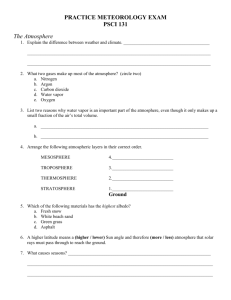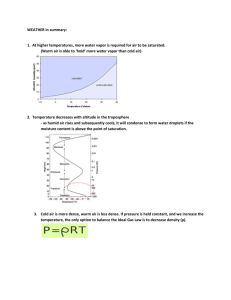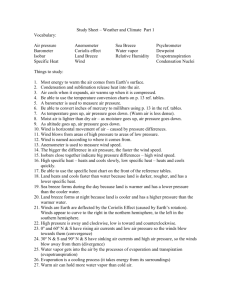Summary Notes for Chapter 14
advertisement
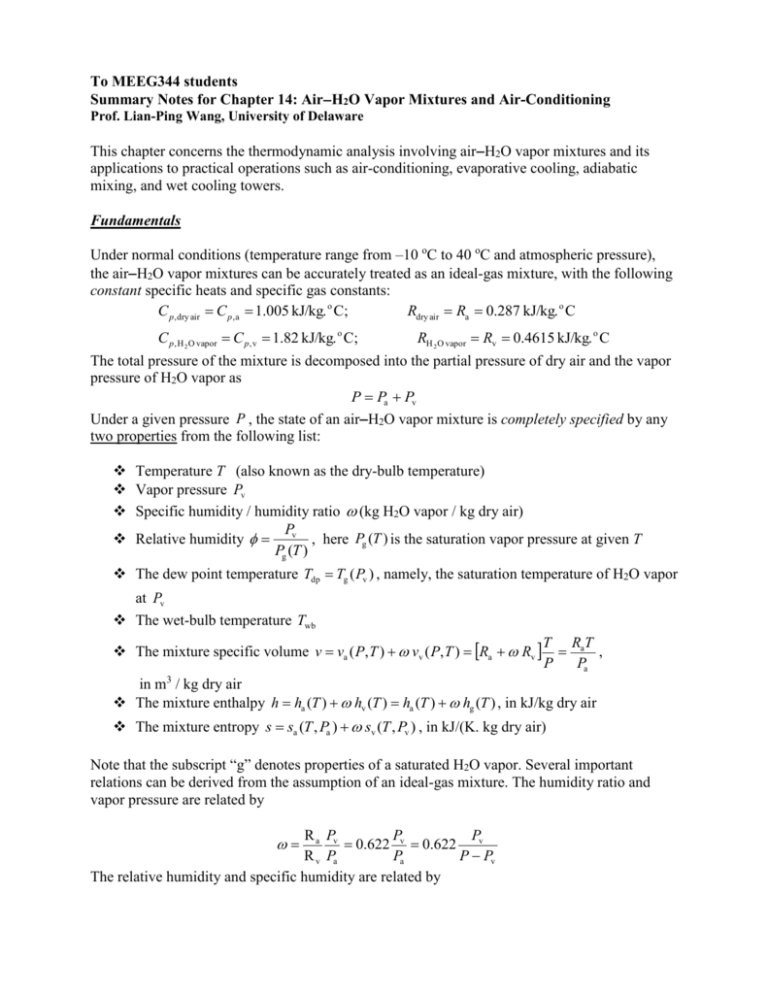
To MEEG344 students Summary Notes for Chapter 14: AirH2O Vapor Mixtures and Air-Conditioning Prof. Lian-Ping Wang, University of Delaware This chapter concerns the thermodynamic analysis involving airH2O vapor mixtures and its applications to practical operations such as air-conditioning, evaporative cooling, adiabatic mixing, and wet cooling towers. Fundamentals Under normal conditions (temperature range from –10 oC to 40 oC and atmospheric pressure), the airH2O vapor mixtures can be accurately treated as an ideal-gas mixture, with the following constant specific heats and specific gas constants: C p , dry air C p , a 1.005 kJ/kg. o C; Rdry air Ra 0.287 kJ/kg. o C C p , H 2 O vapor C p , v 1.82 kJ/kg. o C; RH 2 O vapor Rv 0.4615 kJ/kg. o C The total pressure of the mixture is decomposed into the partial pressure of dry air and the vapor pressure of H2O vapor as P Pa Pv Under a given pressure P , the state of an airH2O vapor mixture is completely specified by any two properties from the following list: Temperature T (also known as the dry-bulb temperature) Vapor pressure Pv Specific humidity / humidity ratio (kg H2O vapor / kg dry air) P Relative humidity v , here Pg (T ) is the saturation vapor pressure at given T Pg (T ) The dew point temperature Tdp Tg ( Pv ) , namely, the saturation temperature of H2O vapor at Pv The wet-bulb temperature Twb The mixture specific volume v va ( P, T ) vv ( P, T ) Ra Rv T RaT , P Pa in m3 / kg dry air The mixture enthalpy h ha (T ) hv (T ) ha (T ) hg (T ) , in kJ/kg dry air The mixture entropy s sa (T , Pa ) sv (T , Pv ) , in kJ/(K. kg dry air) Note that the subscript “g” denotes properties of a saturated H2O vapor. Several important relations can be derived from the assumption of an ideal-gas mixture. The humidity ratio and vapor pressure are related by R a Pv P P 0.622 v 0.622 v R v Pa Pa P Pv The relative humidity and specific humidity are related by 0.622 Pg , P Pg P 0.622 Pg The wet-bulb temperature is related to the adiabatic saturation process, namely, Twb is the temperature of the mixture if the mixture is brought to saturation adiabatically by adding saturated liquid water at the final temperature. , T , and Twb are related by C (T T ) (Twb , 100%) hfg (Twb ) 0.622 Pg (Twb ) p,a wb , where (Twb , 100%) hg (T ) hf (Twb ) P Pg (Twb ) The specific entropy of the water vapor sv (T , Pv ) can be calculated by P T . sv (T , Pv ) sg (T ) Rv ln v sg (T ) Rv ln or sv (T , Pv ) sg ( Pv ) Cp,v ln Pg (T ) Tdp For convenience, the psychrometric chart (A-31) is designed to help look up properties at P =1 atm. For other total pressures, the above relations must be used to obtain unknown properties of a specified state. Applications Air-conditioning processes include simple heating, simple cooling, humidification, dehumidification, or combinations of these. The thermodynamic analysis considers mass conservation of dry air, mass conservation of H2O, energy conservation, and entropy balance. Under the assumption of a steady-state, steady-flow process, m a,i m a,e m i a, i m w,i e m a, e m w,e Q W m a, e he m w,e hw,e m a, i hi m w,i hw,i Q Sgen m a, e se m w,e sw,e m a, i si m w,i sw,i j Tj I T0 Sgen where the subscript “i” for inlet, “e” for outlet, “w” for pure H2O addition (humidification) or removal (dehumidification). The same method of analysis can be applied to evaporative cooling, adiabatic mixing, and wet cooling towers. Evaporative cooling is a low-cost cooling method taking advantage of the high value of latent heat absorption to create “cooling” effect; the wet-bulb temperature remains roughly constant during the evaporative cooling process. Adiabatic mixing of two airstreams can produce a mixture of intermediate humidity ratio. Wet cooling towers are used to cool warm water from power plant using atmospheric air as the heat sink reservoir, due to the abundant, free supply of the atmospheric air!!!
